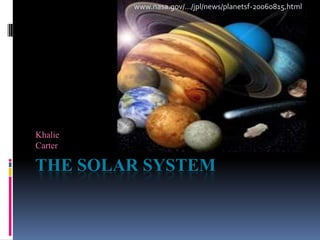
NASA Discovers New Moons Orbiting Jupiter
- 2. Table of Contents The Big Bang Theory Outer Planets Inner Planets The Moons References
- 3. www.scienceblogs.com Big Bang Theory What is the Big Bang Theory? An explanation of what happened at the beginning of our universe. When did this all take place? About 15 billion years ago our universe sprang into creation. The Bang A huge explosion happened that expanded the universe. All the matter and energy were contained at one point. Was it a REAL explosion? It was a not an explosion like a bomb, matter of fact it was explosion of space within itself.
- 4. Outer Four Planets Jupiter Astroversity.blogspot.com The largest planet. Outer atmosphere is very cold, but inside the planet it gets hotter and hotter towards the core. Takes 12 Earth years to get around the sun. Has rings around it, and a gravitational pull 10,000 times stronger than the Earth. Saturn Second largest planet in our solar system. Almost 10 times larger than Earth. Takes almost 30 Earth years to get around the sun. From a distant looks yellowish, but is really pale yellow, golden brown, and reddish brown. Has 22 moons. Titan is one of them, which is one of the largest in the solar system.
- 5. Outer Four Planets Uranus Third biggest planet, 4 times bugger than the Earth. Astroversity.blogspot.com Only discovered about 200 years ago. It is fuzzy and blue. Tipped over, so it looks like it’s rotating completely on it’s side. Takes almost 42 Earth years. 15 moons Neptune A little smaller than Uranus. Farthest away from the sun. Takes 165 Earth years to get around the sun. Has 2 rings that circle it. Has 3 satellites.
- 6. Inner Planets Mercury Astroversity.blogspot.com The closest planet to the sun. The smallest known planet. Weak magnetic field around mercury, and the atmosphere is much thinner than the Earths. Moves around the sun much faster than the Earth. Days are terribly hot and the nights are terribly cold. Venus A little smaller than the Earth. Closest planet to the Earth. Takes more than half a year to turn on it’s axis. Clouds swirl around fast, 250 miles an hour, faster than ANY hurricane. Very HIGH temperatures day and night.
- 7. Inner Planets Earth Astroversity.blogspot.com The third plane from the sun. Covered with 3 times more water than land. Has a magnetic field all around it. Takes 24 hours to make one rotation. Life is possible almost anywhere. Natural satellite is the moon. Mars Farthest inner planet from the sun. It is a bit more colder on Earth, but it has volcanoes, lava fields, and canyons. Atmosphere is much thinner than Earth’s, and fully of carbon monoxide. Has seasons. Has 2 satellites.
- 8. How many moons? www.gearthblog.com Earth Has 1 moon. Jupiter Has 63 moons. Saturn Has 60 moons. Uranus Has 27 moons. Neptune Has 13 moons.
- 9. www.gearthblog.com Our Moon How big is the moon? 2,000 miles across. How far is the moon from the Earth? 250,000 miles. How old is the moon? www.sos.noaa.gov 4.5 billion years old. How did the moon form? The Earth and moon formed at the same time. Earth was formed by big chunks and icy material, and then a big piece knocked into the Earth and knocked a big piece loose and that became the Earth.
- 10. References "THE BIG BANG." University of Michigan. Web. 05 Feb. 2010. <http://www.umich.edu/~gs265/bigbang.htm>. "The Moon | Scholastic.com." Teaching Resources, Children's Book Recommendations, and Student Activities | Scholastic.com. Web. 05 Feb. 2010. <http://www2.scholastic.com/browse/article.jsp?id=4850>. "Table of Moons in our Solar System." Windows to the Universe. Web. 05 Feb. 2010. <http://www.windows.ucar.edu/tour/link=/our_solar_system/moons_table.h tml>. "The Inner Planets | Scholastic.com." Teaching Resources, Children's Book Recommendations, and Student Activities | Scholastic.com. Web. 05 Feb. 2010. <http://www2.scholastic.com/browse/article.jsp?id=4846>. "The Outer Planets | Scholastic.com." Teaching Resources, Children's Book Recommendations, and Student Activities | Scholastic.com. Web. 05 Feb. 2010. <http://www2.scholastic.com/browse/article.jsp?id=4854>.